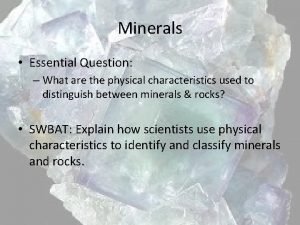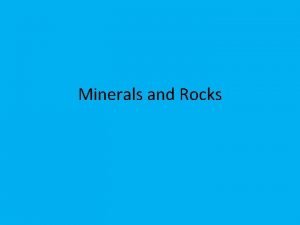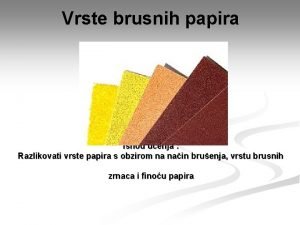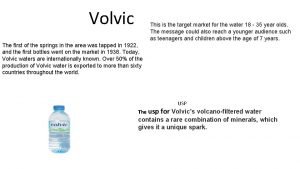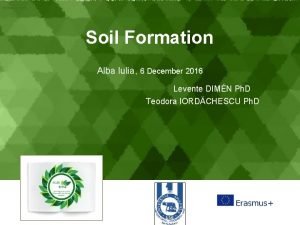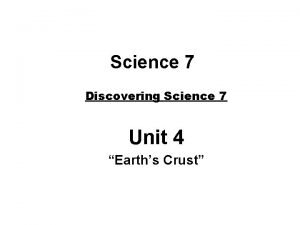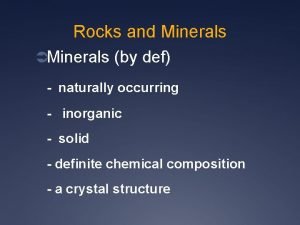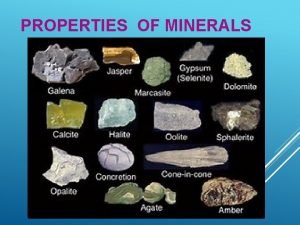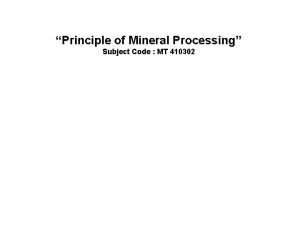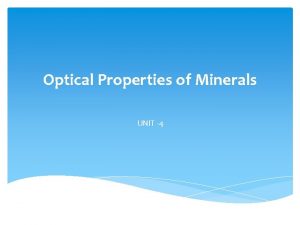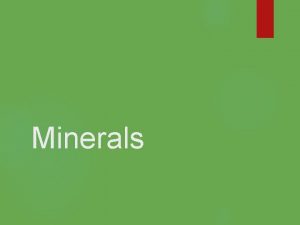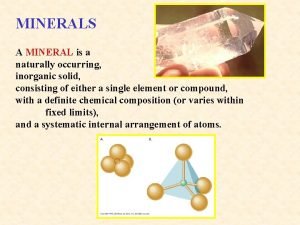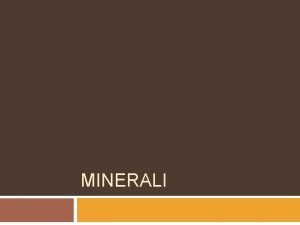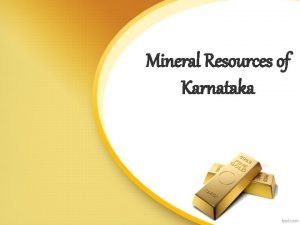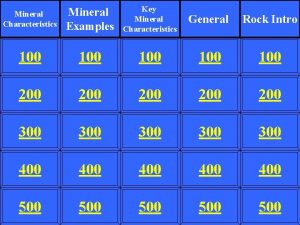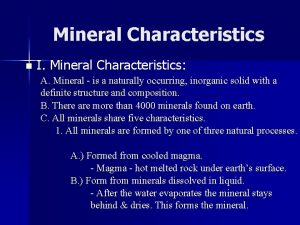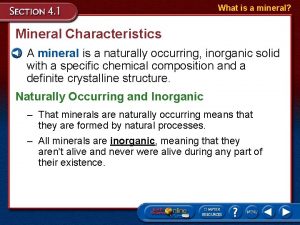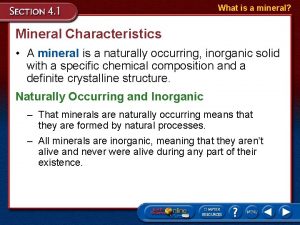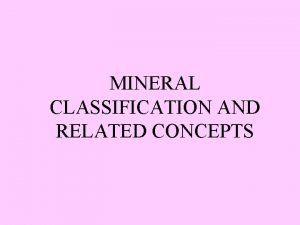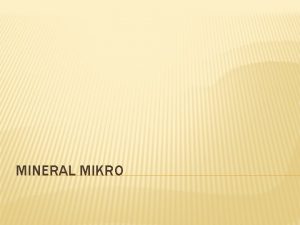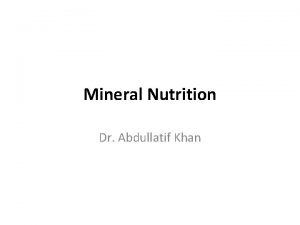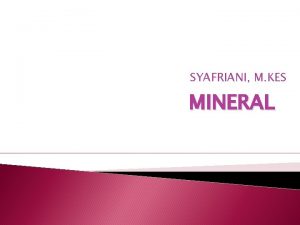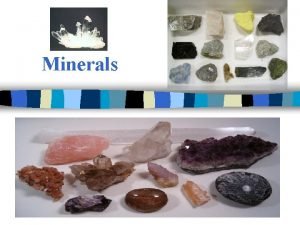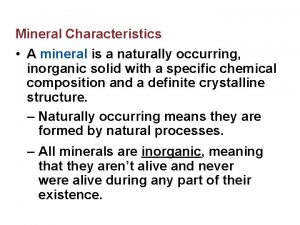Mineral Characteristics I Mineral Characteristics A Mineral is














- Slides: 14

Mineral Characteristics • I. Mineral Characteristics: A. Mineral - is a naturally occurring, inorganic solid with a definite structure and composition. B. There are more than 4000 minerals found on earth. C. All minerals share five characteristics. 1. All minerals are formed by one of three natural processes. A. ) Formed from cooled magma. - Magma - hot melted rock under earth’s surface. B. ) Form from minerals dissolved in liquid. - After the water evaporates the mineral stays behind & dries. This forms the mineral.

C. ) New minerals could form from existing minerals. -They could be transformed by: -Heat -Pressure -Chemical Reaction -Mineral atoms change without melting, allowing the atoms to recombine in new ways.

Mineral Characteristics Cont. 2. All minerals are inorganic. A. ) Minerals are not alive, never were, and were not made up by once living things. B. ) Example: Is coal a mineral? Is Oil a mineral? Coal and Oil formed from one living things. 3. All minerals are solid and have a definite shape. A. ) Liquids + Gases could never be minerals because they do not have a definite shape. 4. All minerals have definite chemical compositions. A. ) Some rocks are made of different things. 5. A mineral’s atoms are arranged in a definite pattern, that repeats over and over again.

Mineral Characteristics Cont. A. ) The repeating pattern of atoms are called crystals. B. ) When magma cools slowly, large crystals form. C. ) When magma cools rapidly, small crystals form. • II. Mineral Identification: A. Properties of minerals: Appearance - you cannot rely on a minerals appearance alone to tell them apart. Ex. Gold and Pyrite (Fools Gold). 1. Hardness - is how easily a mineral can be scratched. A. ) We can use hardness to identify minerals by using the Mohs Scale of Hardness.

Questions • • • About how many minerals are found on earth? What are the five characteristics that all minerals must have? What are three ways a mineral can form naturally? Why is coal not a mineral? Can liquids or gases ever be minerals? Why?

“Mineral Identification Cont. ” B. ) An object with a hardness of 1 is the softest, and an object with a hardness of 10 is the hardest mineral. C. ) Objects with the same hardness will scratch each other. D. ) Which mineral is harder Quartz or Calcite? 2. Luster - Describes how light is reflected from the mineral’s surface. A. ) Luster will be either metallic or nonmetallic. B. ) Metallic - shines like metal. C. ) Nonmetallic - does not shine like a metal. D. ) Ex. Gold - metallic, Quartz - nonmetallic.

“Mineral Identification Cont. ” 3. Color – The appearance of the mineral in reflected light. What you see to the naked eye. A. ) Usually not enough. B. ) Gold and Pyrite. 4. Streak - is the color of the mineral when it is broken up and powdered. A. ) When a mineral is rubbed across an object with a greater hardness a streak of color is sometimes left behind. B. ) Ex. Gold leaves a yellow streak, and Pyrite leaves a grayish streak.

“Mineral Identification Cont. ” 5. Cleavage - Minerals have cleavage if it can break across a smooth flat surface. A. ) Ex. A layer cake taken apart in layers is broken with perfect cleavage. B. ) Halite and Calcite break with perfect cleavage. 6. Fracture - Minerals that break with rough or jagged edges have fracture. A. ) Grabbing a chunk out of a layer cake would be like breaking a mineral with fracture. B. ) Quartz has fracture.

“Mineral Identification Cont. ” 7. Special Properties - some mineral have unique properties. Examples: A. ) Calcite fizzes when Hydrochloric Acid (HCl) is put on it. B. ) Magnetite is attracted to magnets. C. ) Halite dissolves in water. • III. Uses of Minerals: A. Gems - a valuable mineral highly prized because they are rare and beautiful. 1. Most minerals are forms of gems.

“Uses of Minerals” 2. Example: Amethyst is a gem form of Quartz. 3. The gem’s value depends on its rarity, size and cut. 4. The most rare and valuable gems are called Precious Stones. 5. All other gems are called Semiprecious Stones. A. ) Examples: Amethyst, Turquoise, and Topaz. B. ) Ores - a mineral that contains a useful substance that can be extracted and used for a profit. 1. Iron can be extracted from Hematite. 2. Aluminum can be extracted from Bauxite.

“Uses of Minerals” 3. The value of an ore depends on its supply ; its demand cost of extraction. 4. If it cost raises, or demands fall, a substance may not be considered an ore.

Removing Iron from an ore • Iron ores are typically the iron atom bonded with oxygen. • The metallic iron can be removed from a process called smelting – Iron ore is crushed and mixed with limestone and coke (baked coal) – Mixture is placed in a blast furnace with extremely hot air to make the coke easily burn. – Chemical reactions with the coke changes allow the mixture to form carbon dioxide gas and molten iron – Molten iron sinks to the bottom of the furnace as impurities combine with the limestone to make slag (floating on top). – Slag is removed and iron is poured out through taps.

Processing of iron • 98% of iron is used in the production of steel. • Steel is an alloy made from mostly iron and carbon. – Alloy is a mixture of two or more elements with at least one being a metal.

Questions 6). Can you rely on a minerals appearance or color alone, in identifying a mineral? Why? 7). How do you use the Moh’s hardness scale? 8). If you rub two minerals together and both of them are scratched, what can be said about those two minerals? 9). What is the difference between metallic and nonmetallic? 10). What determines a gemstones value? 11). What determines the value of an ore?
 5 mineral characteristics
5 mineral characteristics Characteristic of minerals
Characteristic of minerals Brusni papir za vodeno brušenje
Brusni papir za vodeno brušenje Evian target audience
Evian target audience Mineral vs organic soil
Mineral vs organic soil Discovering science 7
Discovering science 7 Minerals def
Minerals def Properties of mineral
Properties of mineral 2 product formula mineral processing
2 product formula mineral processing Pengaruh pengolahan terhadap mineral
Pengaruh pengolahan terhadap mineral Prismatic cleavage
Prismatic cleavage Veins are often formed from hot water solutions
Veins are often formed from hot water solutions Mineral vs element
Mineral vs element Svinčevo siv mineral
Svinčevo siv mineral Minerals of karnataka
Minerals of karnataka
